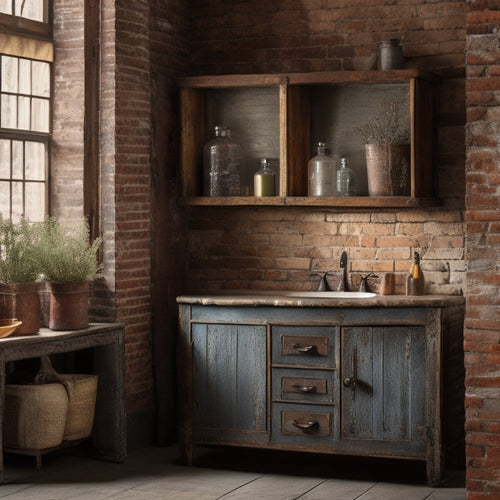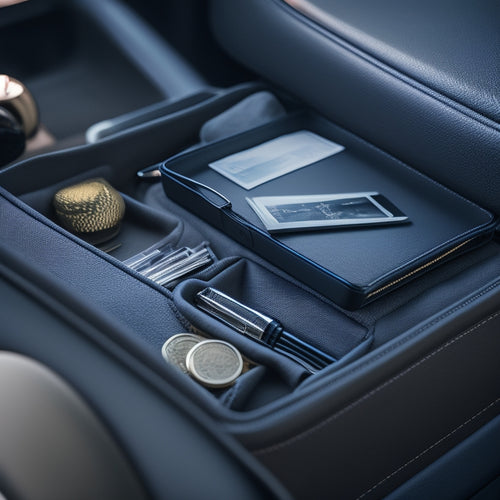
Installing an On Wall Vanity in 5 Easy Steps
Share
You'll start by preparing the wall for mounting, inspecting for electrical outlets, plumbing fixtures, and obstacles, and evaluating the wall structure to determine the right anchors and support. Next, assemble the vanity components, ensuring material compatibility and following manufacturer's instructions for sink attachment. Then, mount the vanity to the wall, locating studs and drilling pilot holes for anchors. After that, connect plumbing and fixtures, identifying faucet types and attaching water supply lines. Finally, finalize the installation, double-checking connections and ensuring a watertight seal – and you're just getting started with perfecting the details of your new on-wall vanity.
Key Takeaways
- Inspect the wall for obstacles and structure, then prepare it for mounting with extra support or specialized anchors if needed.
- Assemble the vanity components, ensuring material compatibility and following manufacturer's instructions for sink attachment to countertop.
- Mount the vanity to the wall by locating studs, drilling pilot holes, and securing it with anchors and mounting hardware.
- Connect plumbing and fixtures, including water supply lines, faucet, P-trap, and drainpipe, and check for leaks.
- Finalize the installation by double-checking connections, caulking gaps, and installing decorative trim or molding for a finished look.
Prepare the Wall for Mounting
Get ready to prep the wall for your new on-wall vanity by taking a closer look at its current state.
You'll want to inspect the area for any electrical outlets, plumbing fixtures, or other obstacles that might interfere with your mounting plans.
Make a mental note (or a physical one, if you're a list person) of any adjustments you'll need to make to accommodate these features.
Next, assess the wall's structure.
Is it drywall, plaster, or something else?
This will impact your wall preparation and mounting techniques.
If you're dealing with drywall, you might need to add extra support or use specialized anchors to guarantee a secure hold.
For plaster walls, you may need to use a different type of fastener altogether.
Assemble the Vanity Components
With your wall prepared, turn your attention to the vanity components, which typically include the cabinet, countertop, sink, and faucet. It's time to bring all these pieces together, and we're excited to see your design come to life!
Take inventory of your components and verify everything is accounted for. Now, let's plunge into the assembly process:
-
Material selection matters: Verify that all components are made from compatible materials. For instance, if your cabinet is made of solid wood, confirm the countertop and sink are also wood-friendly.
-
Design considerations: Think about the overall aesthetic you want to achieve. Will your faucet be wall-mounted or deck-mounted? How will the sink's shape complement the cabinet's design?
-
Countertop and sink integration: Follow the manufacturer's instructions to securely attach the sink to the countertop. This might involve applying adhesive, tightening clips, or using specialized fasteners.
Remember to handle the components with care, as they can be delicate. If you're unsure about any assembly steps, consult the manufacturer's instructions or seek professional assistance.
You're one step closer to a stunning on-wall vanity!
Mount the Vanity to Wall
Behind the scenes of your on-wall vanity's installation, a sturdy mounting system is vital to guarantee a secure and level fit. You don't want your new vanity to come crashing down, do you? To avoid any mishaps, it's imperative to choose the right mounting techniques and wall reinforcement.
First, locate the wall studs using a stud finder or by knocking gently on the wall to detect the solid sound of a stud. Mark the spot where you'll be mounting the vanity. Next, drill pilot holes into the marked area and insert the wall anchors provided with your vanity. Make sure they're securely fastened to the wall studs.
Now, lift the vanity onto the wall anchors, ensuring it's level and plumb. Use shims if necessary to achieve a perfect fit. Finally, screw the vanity into place using the mounting hardware provided.
Double-check that everything is secure and level before moving on to the next step. With a solid mounting system in place, you can rest easy knowing your on-wall vanity is safe and secure.
Connect Plumbing and Fixtures
Now that your on-wall vanity is securely mounted, it's time to focus on connecting the plumbing and fixtures. This step requires attention to detail and the right plumbing tools. You'll need to connect the water supply lines to the vanity, ensuring they're securely attached to avoid leaks.
To get started, identify the type of fixtures you're working with, such as single-handle or widespread faucets. This will determine the specific connections you need to make.
Here's a general overview of the process:
- Connect the water supply lines to the shut-off valves, making sure they're securely tightened.
- Attach the faucet to the vanity, following the manufacturer's instructions for specific fixture types.
- Connect the P-trap and drainpipe to the sink, ensuring a watertight seal.
Remember to turn on the water supply and check for leaks before moving on to the next step. With these connections made, you'll be one step closer to completing your on-wall vanity installation.
Finalize the Installation Process
Every component is in place, and you've successfully connected the plumbing and fixtures; the final stretch of your on-wall vanity installation is within reach.
Now, it's time to finalize the installation process. Double-check that all connections are secure and tightened properly to avoid any leaks or issues. Confirm the vanity is level and plumb, making adjustments as needed.
Inspect the entire installation, paying attention to design considerations such as the alignment of the sink and faucet, as well as material choices like the type of countertop and finish. Make any necessary adjustments to achieve a seamless look.
Next, caulk the gaps between the vanity and wall to create a watertight seal. Finally, install any decorative trim or molding to conceal any exposed edges or gaps.
Take a step back and admire your handiwork! With these final steps, your on-wall vanity installation is complete. Be proud of yourself for tackling this project – you've earned it!
Frequently Asked Questions
Can I Install an On-Wall Vanity on a Plaster Wall?
You can install an on-wall vanity on a plaster wall, but you'll need to prep that wall with extra care, ensuring it's sturdy enough to hold the weight. Research specialized vanity mounting techniques for plaster walls to avoid any, ahem, "cracking" issues.
Do I Need a Permit to Replace My Existing Vanity?
Before you start demo day, don't get caught in a permit limbo! You'll likely need a permit for vanity installation, but it depends on your local regulations and the scope of the project - check with your local authorities to avoid a costly surprise.
How Do I Clean the Minimalist Gap Between Vanity and Wall?
You'll conquer the art of cleaning that pesky gap between vanity and wall with the right cleaning tools, like a trusty toothbrush or slim vacuum, and some savvy maintenance tips, like regular dusting and occasional deep cleans to keep it spotless!
Are On-Wall Vanities Suitable for Wheelchair-Accessible Bathrooms?
You're wondering if on-wall vanities are suitable for wheelchair-accessible bathrooms - and rightly so! You'll be relieved to know that, with careful planning, they can be a great option, offering improved accessibility features, like installation at a comfortable height, for a more inclusive space.
Can I Use an On-Wall Vanity With a Bidet Toilet Combo?
You're wondering if you can pair an on-wall vanity with a bidet toilet combo? Yes, you can! Verify bidet compatibility by checking the vanity's height and clearance specs, then adjust the bidet's position to fit snugly underneath, and voilà!
Conclusion
You've reached the finish line! Installing an on-wall vanity is like maneuvering through an obstacle course - it requires precision, patience, and practice. But now, you've conquered the challenges and emerged victorious. Your new vanity is like a crown jewel, adorning your bathroom with elegance and sophistication. Stand back, admire your handiwork, and bask in the glory of a job well done!
Related Posts
-

Sleek Shower Organizers for Contemporary Homes
Sleek shower organizers are essential for a contemporary home, blending aesthetics with function. By utilizing vertic...
-

Vintage Metal Bathroom Storage for Industrial Look
If you're aiming for that chic industrial look in your bathroom, vintage metal storage is the perfect choice. These p...
-

High Road Car Glove Box Organizer Review
The High Road Car Glove Box Organizer is a top-rated solution for keeping vehicle documents and essentials neatly org...


